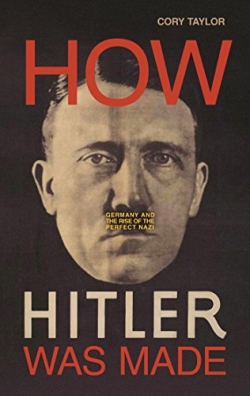Does the world need yet another book about Adolf Hitler?
To my mind, three British prominent historians – Alan Bullock, Richard J. Evans, and Ian Kershaw – have definitively covered the subject for English-speaking readers.
Still, fascination of the German Fuhrer does not abate, as evidenced by Cory Taylor’s addition to the genre with How Hitler Was Made: Germany and the Rise of the Perfect Nazi (Prometheus Books, Amherst, New York, 2018). An Emmy award-winning documentary filmmaker, Taylor delves into Germany’s post-World War I years (1918-1924), the time when Hitler became “the perfect Nazi.”
The first 104 pages of his 274-page book detail the political upheavals in Munich, the Bavarian capital, during the six chaotic years following the 1918 Armistice and the collapse of the German Empire. We learn of Soviet-style leaders in Bavaria, coups and counter-coups, assassinations, street clashes pitting Communists against armed right-wing army veterans, and the emergence of gangs of thugs who emulated the brutal tactics of Italian fascist leader, Benito Mussolini.
Several radical-left leaders during this period in Munich were Jews, among them Kurt Eisner, Eugen Leviné, and Ernst Toller. The author pays special attention to Toller, a German army veteran and distinguished playwright, who, in despair, committed suicide in 1939. Toller, who briefly ruled Bavaria, emerges as Taylor’s hero: an intellectual who unsuccessfully tried his hand at governing during one of the worst periods in modern German history.
On page 105, we meet Adolf Hitler, a right-wing Munich beer hall denizen. Taylor takes us down the well-trodden historical path of describing the Austria-born Hitler (1889-1945), describing how Hitler was abused by his bullying father and, how, in contrast, he enjoyed a loving relationship with his mother until her untimely death from cancer. A homeless vagrant in pre-1914 Vienna, Hitler failed as an aspiring artist but discovered “meaning in life” as a soldier in the “Great War.”
Humiliated by the German defeat, Hitler raged against the perfidious “Berlin politicians,” whom he accused of betraying the glorious German army and people by surrendering to the Allies.
He blamed the defeat on civilian leaders and war profiteers, especially Jews and Socialists. In the turbulent Munich of the 1920s, Hitler found his oratory could stir raw emotions of hatred. It is at this point in his book that Taylor offers a novel interpretation of Hitler’s rise.
A few ambitious right-wing political figures in Munich systematically groomed the former corporal into the national leader he would become. Until this sinister group of extreme German ethnic nationalists plucked Hitler from his purposeless despondent life, the future Nazi dictator could never have gained power in January 1933. Without that early manipulation, Taylor insists, World War II and the Holocaust might never have happened.
One must question this conspiracy theory: that Hitler was like a malleable piece of human clay, easily shaped by an off-stage evil cabal. In such a scenario, one might expect Hitler to show a debt of obedience and loyalty to his creators – two traits lacking in Hitler’s DNA. Moreover, Hitler needed no anti-Semitic indoctrination; by 1918, he was a dangerous, full-blown hater of Jews and Judaism. Nor did he require lessons from his “masters” in learning to loathe democratic institutions and democracies.
Hitler made no secret his contempt for the Western Powers and the Soviet Union. He demeaned Britain as a “nation of shopkeepers”; called America “a mongrel nation”; saw Slavs, especially Russians, as “sub-human”; and labeled the French a degenerate people whose 1918 victory had to be avenged.
Taylor’s book, which contains an excellent bibliography and useful endnotes, provides important details about the seething cauldron that was post-WWI Munich, a political cesspool from which a mass murderer and political monster emerged.
Rabbi A. James Rudin is the former head of the American Jewish Committee’s Department of Interreligious Affairs and author of seven books, most recently, Pillar of Fire: A Biography of Stephen S. Wise.



